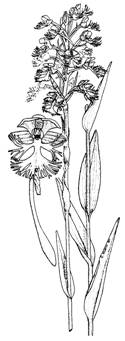Eastern prairie fringed-orchid COSEWIC assessment and status report: chapter 5
Species Information
Name and Classification
Scientific name:
Platanthera leucophaea (Nuttall) Lindley sensu stricto
Common Name:
Eastern Prairie Fringed-orchid; Eastern Prairie Fringed-Orchid
Family:
Orchidaceae (orchid family)
Major Plant Group:
Monocot flowering plant
The genus Platanthera (tribe Orchideae of subtribe Orchidinae) includes about 200 orchid species in the temperate region of both hemispheres (Dressler 1981). The group of fringed-orchids is confined to North America and within that group, the Eastern Prairie Fringed-orchid belongs to a group of five species (P. leucophaea, P. psycodes, P. grandiflora, P. peramoena, P. praeclara). The common name has been adopted as Eastern Prairie Fringed-orchid (Whiting and Catling 1986, Case 1987), with the hyphen in “Fringed-orchid” denoting that the species belongs to a group of orchids with a fringed lip.
Recent studies of the phytogeography, variation or classification of Eastern Prairie Fringed-orchid have a major impact on status designation. The original status report was based on presumed occurrence in Manitoba where it was discovered by Catling and Brownell on 26 July 1984. The Manitoba population included approximately 500 plants (vegetative and flowering) at the time of the report, and these plants occurred over an area of 10 hectares (Brownell 1984, Johnson 1985). The Manitoba plants were all lost to a taxonomic change in 1986 (Sheviak & Bowles 1986, Catling and Brownell 1987), when they were accepted as a new species, the Western Prairie Fringed-orchid (Platanthera praeclara Sheviak and Bowles). Gleason and Cronquist (1991) made praeclara a variety of P. leucophaea, but this is inappropriate given its fully distinctive characteristics.
The 1984 status recommendation was based on the Manitoba population plus 712 plants known in Ontario in the early 1980s, and an extreme maximum number of 2243 plants known from the 1960s until the early 1980s (considering maximum numbers over about 20 years at all sites). The Manitoba population thus represented 41% (500 of 1212) of the plants known in the early 1980s when the original status report was prepared and 18% (500 of 2743) of the maximum number of plants suspected in Canada. Thus, loss of the Manitoba population was a substantial change in the total population size not to mention the loss of range, habitat and extent.
Natural hybrids involving P. leucophaea from Ontario have been described recently from site 31 (Catling et al. 1999) and sites 32 and 34 (Catling and Brownell 1999). These have been named Platanthera xreznicekii (Platanthera psycodes x leucophaea) and Platanthera xhollandiae (Platanthera lacera x leucophaea) respectively. These natural hybrids not only have a bearing on taxonomic relationships, but are of potential significance (1) in monitoring due to the identification problems created by intermediates and (2) genetic dilution, pollination interference, etc.
Description
The Eastern Prairie Fringed-orchid is a 0.5-1 m tall plant with lanceolate leaves and a spike of 10-40 whitish flowers each with a prominent fringed petal and a long spur. A good formal description, keys and a colour photograph are provided by Case (1987) and more technical information involving a morphological comparison of P. leucophaea and P. praeclara is provided by Sheviak and Bowles (1986). Also refer to the original status report for a description (Brownell 1984). An inflorescence of a plant from Ontario is shown in Figure 1.
Figure 1. Eastern Prairie Fringed-orchid (Platanthera leucophaea) from Mitchell and Sheviak 1981
